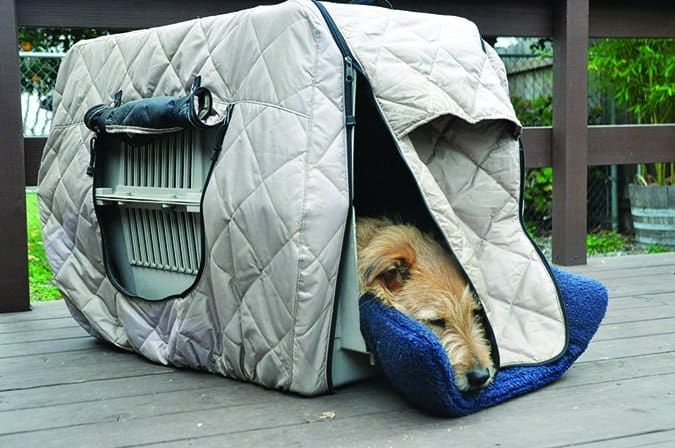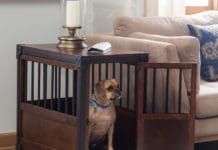DOG CRATING ISSUES: WHAT YOU’LL LEARN
1. To evaluate your crating protocols and make any necessary changes (bedding? location? type of crate?) to ensure you are following best crating practices.
2. To help your dog learn to love his crate in case a time comes when he must be confined, for an extended stay at the vet, for example, or (dog forbid) an evacuation.

I first used a crate as a canine management tool in the early 1980s. I was a little skeptical of the concept (“Put my dog in a box? What?”), but within two days was completely convinced that this newly touted training tool had merit for both housetraining puppies and as a “safe space” for older dogs.
Decades have passed since then, and I continue to believe that crates are a valuable tool for successful dog keeping. However, I have also seen some crate abuses over the years that prompt me to add some important caveats to my usual encouragement of their use.
Excessive Crate Confinement
Overuse is probably the most common abuse of crates. I cringe when I hear of dogs who are routinely left crated 10 or more hours a day while their humans are away at work. And what if you get stuck in a major traffic back-up, or your boss decides to call a last-minute mandatory staff meeting?
I can’t think of a better way to wreck your dog’s housetraining than to crate him for excessive periods with no option but to soil his own den – not to mention the potential for creating severe anxiety by forcing him to eliminate in his bed against all his training and instincts. While your dog may be physically capable of going for 10-plus hours without soiling his crate, he shouldn’t have to. There is some evidence that over-crating may lead to kidney damage for dogs who routinely try to “hold it” longer than they should.
Some of us (me included) sometimes crate one of their dogs to prevent intra-family aggression. Using a baby gate to separate the dogs, instead, can keep peace in the family and reduce unnecessary confinement.
Solutions: Examine your crating practices. Do you have options other than crating? If your dog can’t have house freedom, will a baby gate or closed door serve the same management function while giving your dog more room to move and a choice to use his crate – or not? (He still shouldn’t be shut in his room for 10-plus hours a day! If he has to be regularly left home alone for long periods, find a reliable force-free dog walker to give him a daily break.)
If you’re not sure your dog can be trusted uncrated, start a testing protocol, gradually leaving him uncrated for increasing periods.
Improperly Introducing Your Dog to the Crate
Nothing is guaranteed to make your dog dislike his crate faster than being forced into it. If your dog shows resistance to crating, stop! Rather than shoving, try tossing high-value treats inside. If he still doesn’t go in voluntarily, find an alternative until you can take the time to teach him.
Solutions: Good breeders teach their pups to love crates, and an increasing number of shelters and rescue groups are making the effort to do the same with the dogs in their care. If not, and you’re bringing him home for the first time, try a harness and a seat belt or tether to safely restrain him for the trip. Or bring along a friend or family member who can hold him.
Once home, use counter-conditioning to convince your new canine companion that being near a crate makes wonderful things happen, and use shaping to operantly condition him to happily and willingly enter his new bedroom.
Crating a Dog as Punishment
Yikes! If forcing to crate is the best way to make your dog hate his crate, using the crate as punishment may be the next-best way. A cheerful time-out is okay – just to remove him from a difficult situation, but never an angry “Bad dog! Get in your crate!” Similarly, never punish him in his crate by banging on it or shaking it. And never, ever reach into his crate to drag him out and punish him. I don’t reach into my dogs’ crates for any reason; crates are their safe space and I respect that.
Solutions:The easy solution here is – just don’t. If you must crate your dog to give him (or you!) a cooling-off period, do it cheerfully, and give him something nice in the crate – yummy treats, a chewy, or a stuffed toy.

Unprotected Crating
You can accidentally give your dog a negative experience and association with the crate by crating him in a place where he is not protected from the unwanted attentions or proximity of others. If your dog isn’t fond of children and you crate him where children can harass him, he will feel trapped and stressed, and you are likely to make his association with children (as well as with his crate) infinitely more negative.
There can be a similar outcome if he has a tense relationship with another dog in your household and you crate him while the other dog is allowed to be free: Trapped and stressed, his relationship with that dog will likely worsen. If he’s crated in your vehicle and you have to swerve or stop suddenly, the crate bouncing around the back of your SUV is likely to convince him he’d rather not be crated.
Solutions: Always crate your dog in a location where he is protected from unwanted attentions from humans or other dogs. An exercise pen placed around the crate as an “airlock” may be adequate, or he may be better off crated in a separate room with a baby gate across or the door closed. Crates in a vehicle should always be secured so they can’t roll around if there is a sudden stop or worse, a collision.
Crating Tips
With all that said, you might think my ardor for crates has cooled. Far from it; I still think they are a fantastic dog management tool, when used properly. Here are some additional tips to help your dog get the most benefit from his crating experience:
1. If your dog has had past unpleasant experiences with crating, consider changes. If you were using an airline-style crate, try a wire crate. If he was crated in the living room, try the den. If he gets aroused by outside stimuli, move the crate away from the front door, to an isolated, quiet location in the house.
2. Make sure your dog’s crate is placed in an environmentally comfortable location. You may not realize that the sun hits the crate at some point in the day, causing your dog to overheat, or a draft from a vent that makes him uncomfortably cold. Try putting crates in different locations and see if he shows a preference.
3. Respect your dog’s bedding preferences. He may love a cushy comforter to lie on while crated, or he may prefer the coolness of a bare crate floor. Figure out what he likes and accommodate his wishes. If possible, try offering two crates with different types of flooring or bedding and see if he chooses one over the other.
4. While you work to shape your dog to voluntarily crate, try putting something wonderfully irresistible inside the crate (near the door at first) and closing the door, so he gets a little frustrated about trying to reach it. Then open the door so he can reach in and grab it. As he gets bolder about grabbing the item, gradually move it farther back so he has to go deeper in the crate to get it.
5. Consider giving your dog more spacious accommodations. When housetraining, we want the crate to be just large enough to stand up, turn around and lie down comfortably, so he can’t soil one end and rest comfortably in the other. After he is well housetrained, there is no need to keep him a small space – he can have a bigger crate if he likes.
So Why Even Crate?
Why bother to crate at all, especially once your dog is housetrained and past the puppy chewing stage? There are times when it can be very useful to be able to crate your dog. It is certainly safest to transport your dog in a vehicle if he is properly crated. Also, there comes a time in the lives of many dogs when they need to be on “restricted activity,” whether following surgery, or perhaps for a torn ACL, broken limb, or some other medical mishap.
A dog who is calm, relaxed, and even happy about being crated will endure these trying times far more easily than one who is stressed about his enforced confinement. Be a responsible crate practitioner, and your dog will be much happier for it.
Author Pat Miller, CBCC-KA, CPDT-KA, is WDJ’s Training Editor. Miller is also the author of many books on positive training. Her newest is, Beware of the Dog: Positive Solutions for Aggressive Behavior in Dogs.






